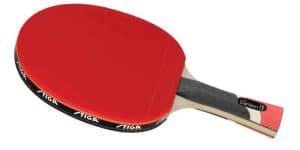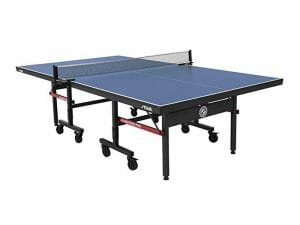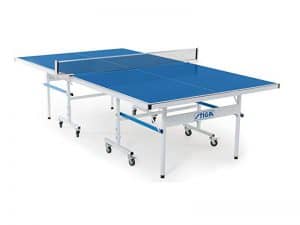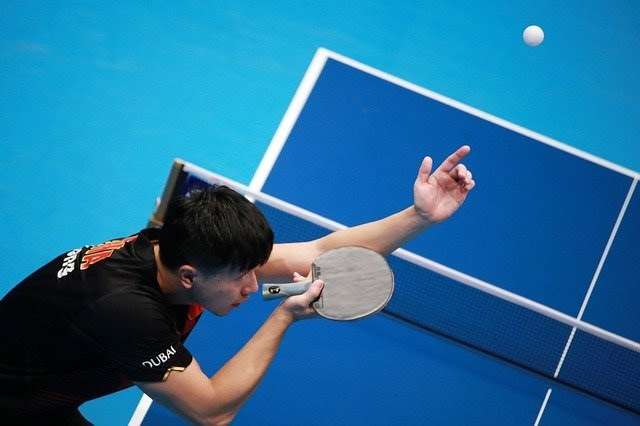DHS Hurricane 3 | The Ultimate Review
- Alex Horscroft
- Last updated
Moving away from typical European-style rubbers, today we take a look at DHS Hurricane 3. Hurricane 3 (H3) leads the charge for Chinese-style rubbers boasting incredible popularity and durability.
While far less common outside of China, lots of players use it. Just yesterday some of my table tennis friends were discussing purchasing a new batch of Hurricane rubbers.
In this guide, I’ll break down what makes Hurricane 3 so different from the rubbers we are used to. Cover its strengths, weaknesses, and some similar products you might like to try.
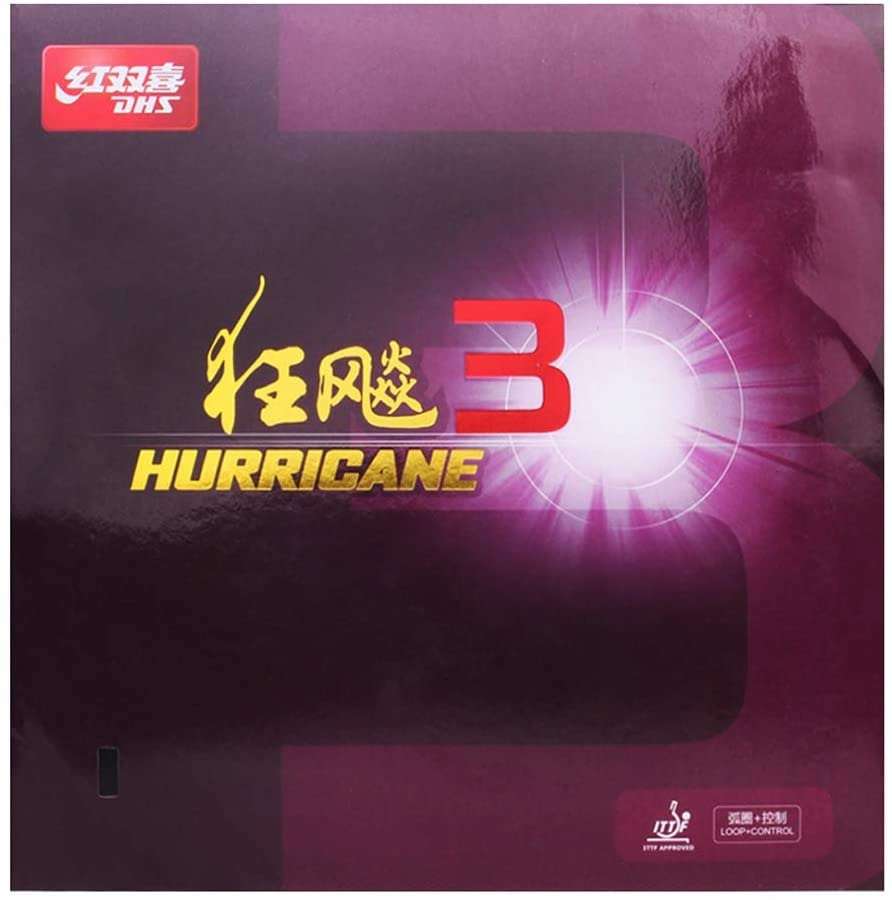
- Speed – 8.1
- Spin – 8.9
- Control – 8.7
- Hardness – Hard
- ITTF Approved? – Yes
- Price – $
- Our rating – 8.6
Table of Contents
Construction
DHS Hurricane 3 is a very tacky rubber, amongst the tackiest available on the market. This means the ball will quite literally cling to the bat if you turn it upside down.
Beneath is a hard orange sponge. H3 weighs more than most rubbers.
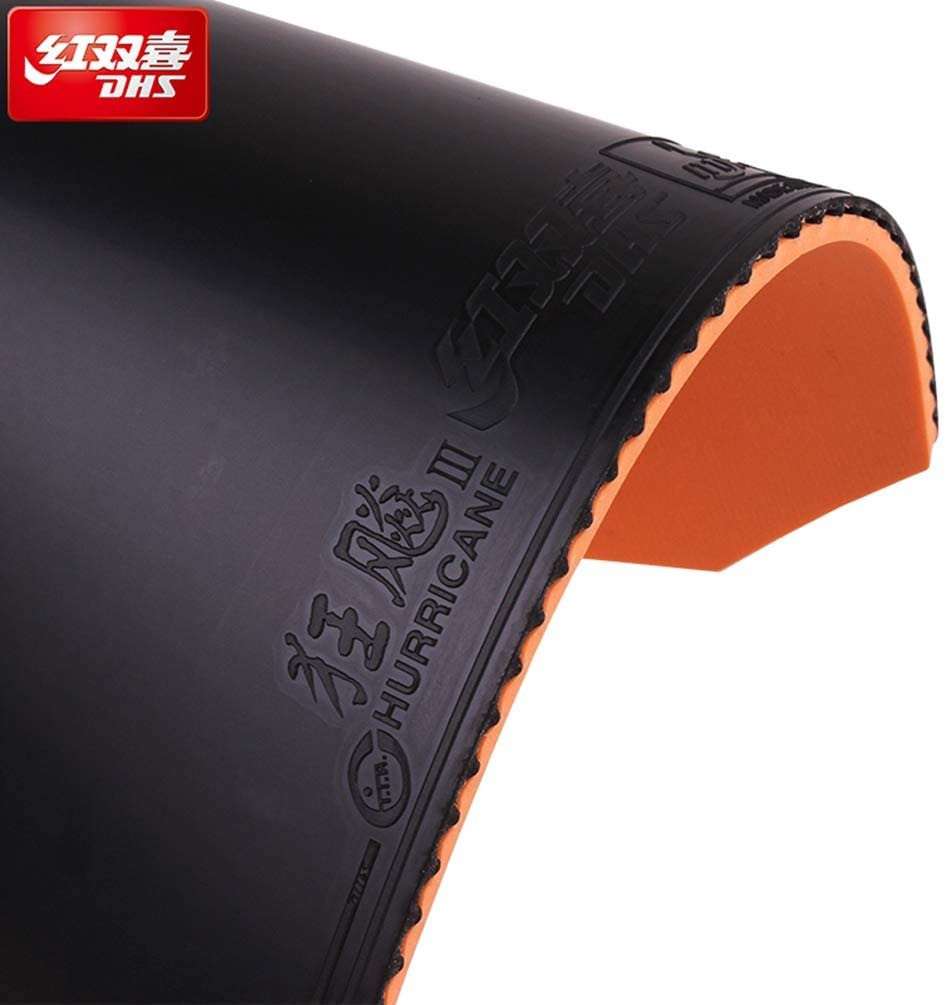
What Table Tennis Pros Use DHS Hurricane 3?
Hurricane 3 is incredibly popular among the top Asian players in the world. It is most commonly paired with a tensor rubber on the backhand, Butterfly Tenergy 05 being the most popular choice.
The highest-ranked player using H3 is Wang Chuqin. Ranked 14 in the world he uses Hurricane 3 on his forehand and Tenergy 05 on his backhand. Doo Hoi Kem is one of the few players to use Hurricane 3 on both her forehand and backhand. She is number 15 in the world.
Yung Fu is another forehand user. She is 55th in the world and has opted to pair Hurricane with Friendship RITC 802.
In fact, Ma Long, former world number 1, is a user of Hurricane rubbers. He uses Hurricane 3 National on his forehand and Neo Hurricane 3 on his backhand. We will touch on these rubbers later.
DHS Hurricane 3 Review
The Positives
- Price – At $25 per sheet, Hurricane 3 gives incredible value for money
- High control – Capable of great control for all shots while still demonstrating good speed for looping
- Versatile – The tackiness of the rubber gives you long dwell time allowing you to perform a range of different strokes
I find swapping between standard European-style rubbers to be a somewhat plain experience. The likes of Tenergy, Rakza, and Bluefire all behave largely as you would expect. Making such a swap presents only minor adjustments that do little to affect your game.
But Hurricane 3, let me tell you, is a different experience altogether. Making the switch to a Chinese-style rubber presents a remarkable change that is welcome when searching for a rubber that fits your unique style. And fear not, the DHS Hurricane 3 rubber is suitable for most levels of play. I’d say from an intermediate level and above.
I distinctly remember my first time being exposed to H3. I was blocking my friend’s loops for a training drill. He had sublime form and I couldn’t for the life of me keep the ball on the table. After my mistakes reached double figures I simply looked at him dumbfounded and apologized. I couldn’t quite put my finger on it, but something was fishy with his loops. He smiled and came over to me and showed me that he was using Hurricane 3 on his forehand. He’d switched bats for the session and I for one could hardly believe the trouble it had caused me.
But enough of the personal anecdotes. What is so different about the Hurricane 3 rubber?
The differences start with its speed. It is more allround+ / offensive– than a flat-out offensive rubber. Differing from most of the top popular rubbers on the market.
Created as a step down in speed from its predecessor, DHS Hurricane 2, it emphasizes improvements in control. And it certainly delivers in that department due to its speed reduction. What is interesting is how the tackiness affects the rubber’s pace.
For looping, you get the most out of H3’s speed. While you do not get a nice catapult effect, you get very spinny loops. Although with strong strokes, you can still get very good speed. Just expect to have to engage a lot more effort than for the likes of Tenergy to reach loop kill speeds.
On the other hand, for blocking, the tackiness seems to deaden the ball a bit. Clinging on before its release, resulting in a long dwell-time and highly controllable blocks.
Perhaps what is more enticing about H3, is its price tag. Coming in at around $25 it blows its main competitors out of the water. Many of us have become accustomed to paying around $70 per sheet, so $25 is a welcome change. In terms of value for money, you really can’t do much better than DHS Hurricane 3.
The Negatives
- Rubber care – Tacky rubbers need a little more TLC than non-tacky rubbers
- Not very forgiving – Strokes such as looping need a little refining to perform well.
- Flat-smashing – Does not excel as a smashing rubber. Best to power loop from height or twiddle to a more powerful rubber
A particular negative you need to be aware of when purchasing H3 is that it needs adequate care. Standard rubbers are not very tacky so rubber care is less important. However, Hurricane 3 is a very tacky rubber. Dirt, dust, and whatever else it makes contact with is attracted to the surface, and if this is not removed it significantly reduces tackiness and therefore the lifespan of the rubber.
Of course, tackiness does fade over time. But a minute or so of care after every session prolongs tackiness longevity. Using a sponge and a spray of rubber cleaner or some water, gently wipe away the dirt on the rubber’s surface. Once it is dry, apply a rubber protection sheet to each side. This will keep it adequately protected while it is not in use.
You may also need to breathe on the rubber during matches to keep it tacky. Table tennis balls leave a powdery coating on rubbers which harms spin production. While not everyone does this, I am a proponent of regularly breathing on rubbers and wiping away this coating with your hand. I would argue it is especially important with tacky rubbers as this coating temporarily removes its tackiness! It is also not practical to break out a cleaner and sponge multiple times per match. So for practicalities sake, a quick breath and wipe does the trick.
Hurricane 3 is also a less forgiving rubber than most. You have to adapt your strokes for looping and smashing which may feel unnatural at first. As stated earlier, you really have to put in a lot of effort to open up this rubbers speed. This is highly taxing on the body and makes it more difficult to reset to the ready position, potentially leaving you vulnerable to counters.
The tackiness of the rubber also makes it very reactive to incoming spin. This could pose an issue when playing with particularly spinny players or anyone with tricky serves.
Furthermore, you could make the argument for a lack of speed. But DHS makes it clear that H3 focuses on a better balance with control. If you are seeking super pacey rubbers, I would look elsewhere.
The greatest reduction in speed occurs for flat-smashing. It is simply not designed for this. There is no chance for the spin to kick in to drive the ball forward. This is why Hurricane 3 is so commonly paired with a tensor rubber on backhand.
Players reap the benefits of the rubber’s versatility on their forehand and when a smash presents itself, they twiddle their bat to their tensor rubber for the smash. It’s quite the strategy and very popular amongst the top Asian players.
Alternatively, you can opt to use power loops from a height to bypass this issue.
About DHS
DHS, or Double Happiness, is a table tennis manufacturer based in Shanghai. Formed in 1959, DHS took just one year to get its table tennis balls officially approved by ITTF. Since this date, its balls have been a mainstay in international competitions.
DHS also produces a range of rubbers and blades. They work closely with the Chinese national team to supply them with the equipment they need to stay on top.
DHS Hurricane 3 Alternatives
DHS has quite the comprehensive assortment of rubbers in its Hurricane range. The rubber Hurricane 3 is most commonly compared with is DHS Hurricane 3 Neo.
DHS Hurricane 3 Neo
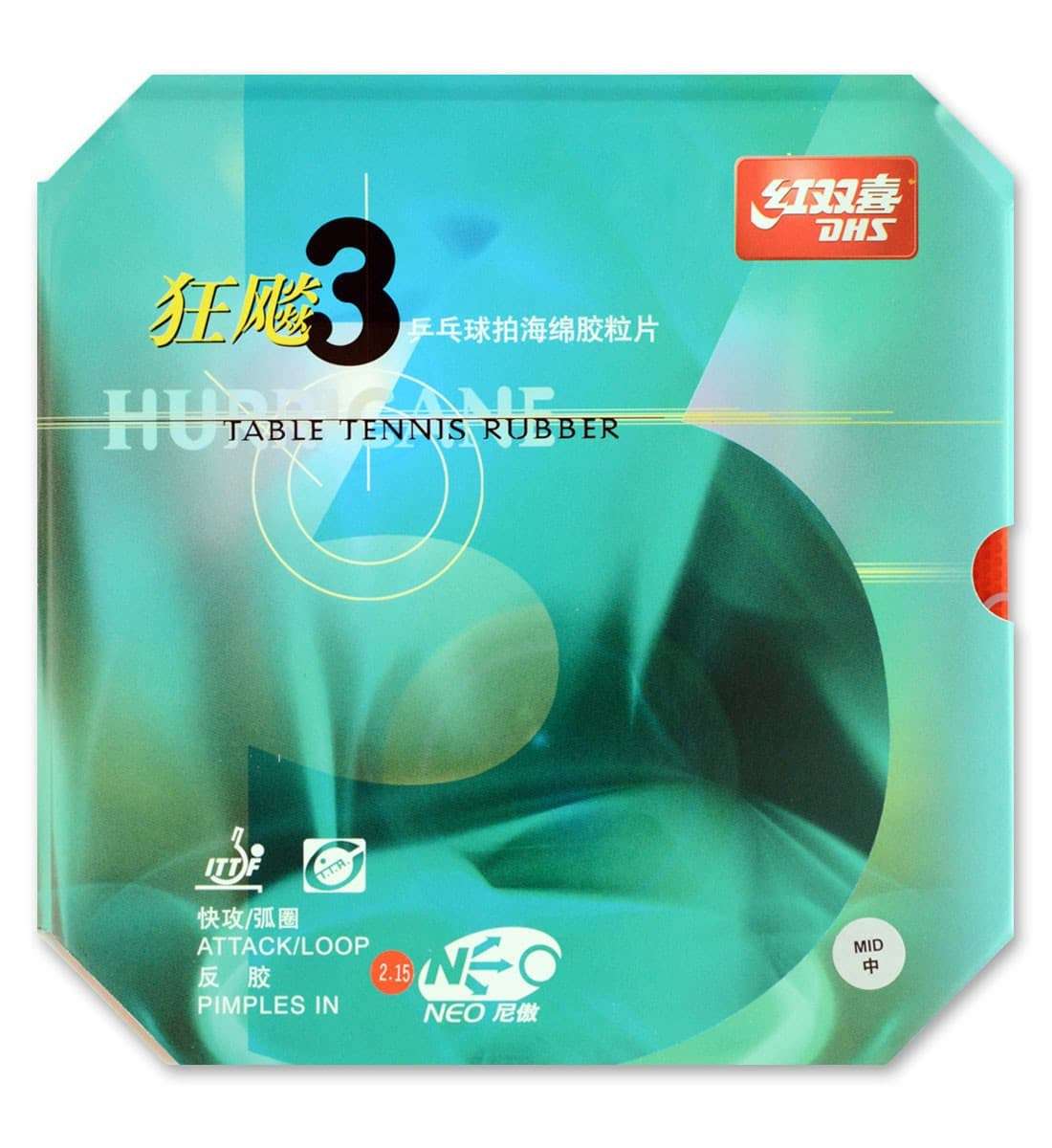
As a brief DHS Hurricane 3 Neo review, the rubber is characterized by an increase in speed and spin over H3 while maintaining the tackiness that players love. It was introduced to circumvent the speed glue ban and is priced a little cheaper than H3. A great option for aggressive attackers. So if you’re torn on Hurricane 3 vs Hurricane 3 Neo, just ask yourself whether you want to play a more controlled, or more aggressive game.
| Image | Name | Speed | Spin | Control | Tacky | Tuned sponge | Hardness | Price |
|---|---|---|---|---|---|---|---|---|
 | DHS Hurricane 3 | 8.1 | 8.9 | 8.7 | Yes | No | Medium-hard | $ |
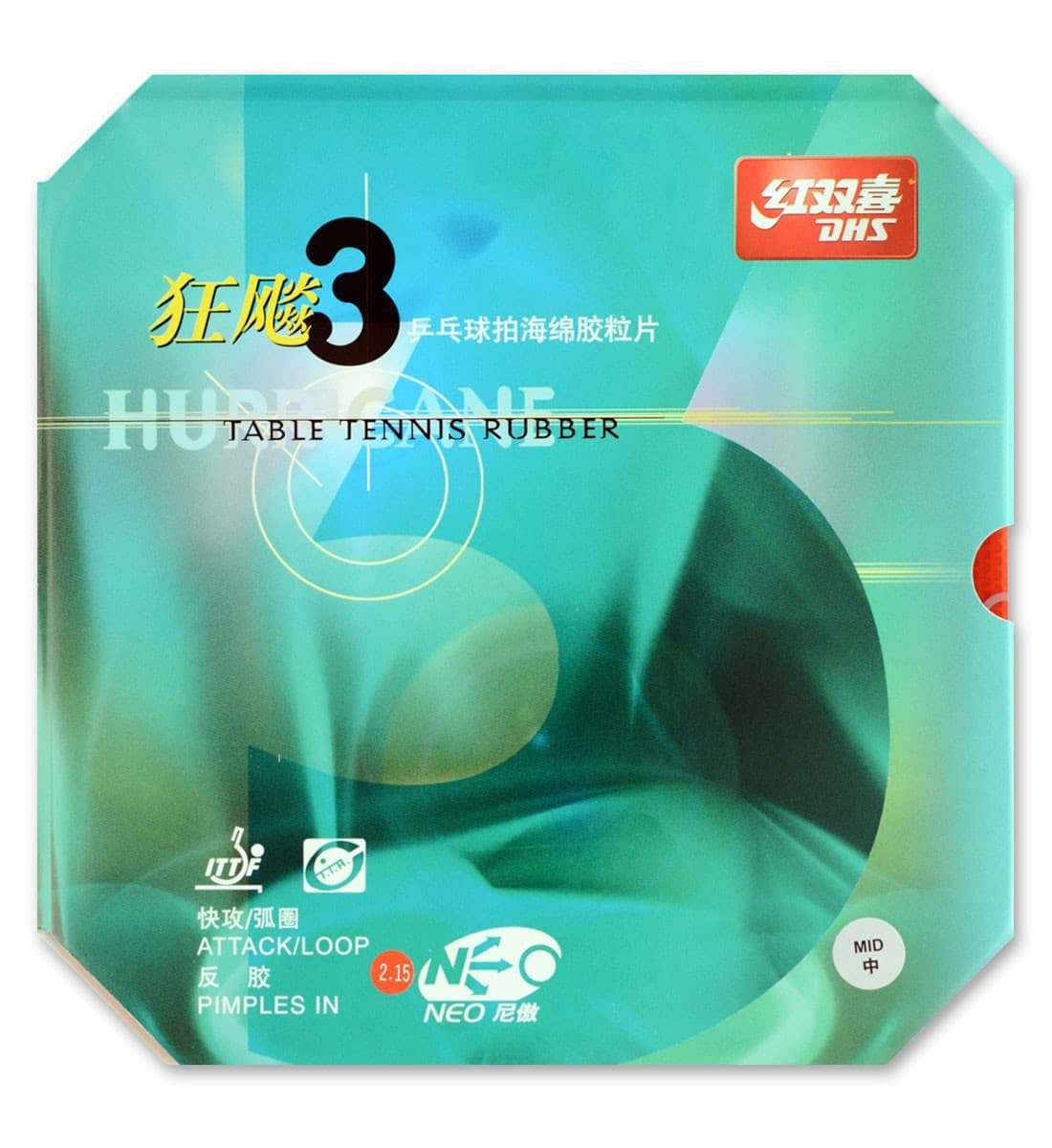 | DHS Hurricane 3 Neo | 8.4 | 9.3 | 8.7 | Yes | Yes | Medium-hard (slightly softer) | $ |
DHS Hurricane 3 National (Blue Sponge)
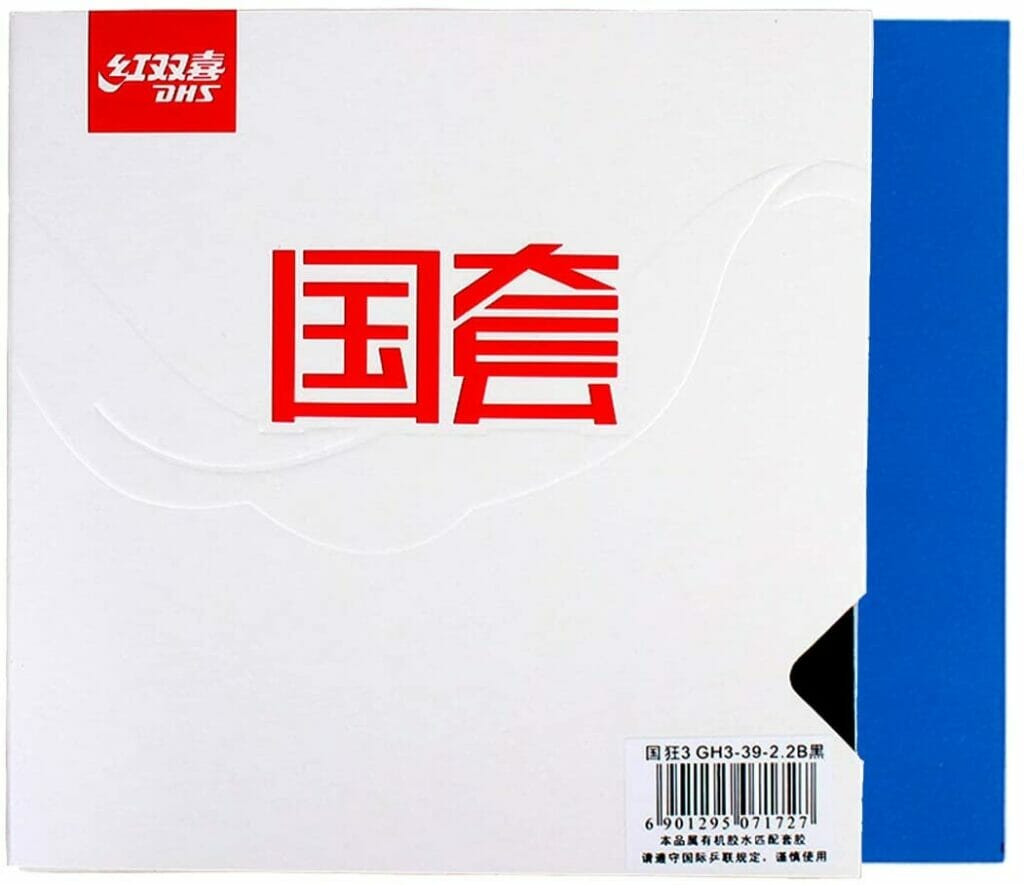
As mentioned earlier, Ma Long uses this rubber on his forehand, and he is well known for having one of the deadliest forehand strokes in the world. DHS Hurricane 3 National is a top-quality rubber that was developed for the Chinese national team.
It’s a pretty rare rubber which is why it costs so much more than ordinary Hurricane rubbers. However, many players feel it far outperforms the like of H3 and H3 Neo, so if you play at an advanced level it may well be worth picking up.
DHS TG Skyline 3 Neo
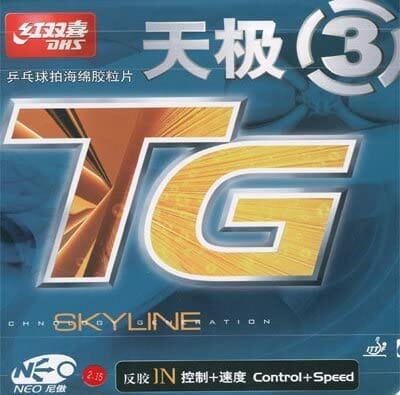
Skyline 3 Neo is another Chinese-style rubber that is tuned like Hurricane 3 Neo. It performs very similarly to this rubber, but it is a little slower and has a lower throw angle. One of the strongest attractions to Skyline 3 Neo is its price which is virtually identical to Hurricane 3.
FAQs
Is DHS Hurricane 3 Good for Beginners?
DHS Hurricane 3 is not ideal for beginners. While it plays in a linear way (which is great for developing players), it is too spinny for beginners to handle. I feel it is a good fit for intermediate levels and up.
What Is the Best DHS Rubber?
DHS produces many exceptional rubbers, and to most players, their national editions tend to be the top performers. These include Hurricane 3 Neo National (blue sponge), and Hurricane 3 National (blue sponge).
How Long Does Hurricane 3 Last?
This largely depends on the quality of the sheet you receive and the rubber care you perform. Assuming you receive a standard sheet and look after it well, it should last at least 6 months with moderate use.
What Is the Difference Between Hurricane 3 and Hurricane 3 Neo?
Hurricane 3 Neo has the same top sheet as Hurricane 3 with a tuned sponge. This causes it to play faster and produce more spin.
Conclusion
That concludes our Hurricane 3 review. DHS Hurricane 3 is one of the most popular Chinese-style rubbers. Its tacky top sheet presents a different style of playing that many players are not used to. Highly spinny, with a range of gears, it is versatile, cheap, and a strong rival for European-style rubbers.
The extensive DHS Hurricane range also provides a great deal of customization if you enjoy the tacky rubber style, but want something a little different to H3.
There is no doubt in my mind Hurricane 3 offers among the best value for money out there. And at its price point, there really is no harm in giving it a try even if you think tacky rubbers are not for you.
Freelance writer. Table tennis enthusiast. Lover of all things online. When I’m not working on my loop game I’m probably binge-watching some fantasy show.
-
Alex Horscrofthttps://pingpongruler.com/author/alex-horscroft/
-
Alex Horscrofthttps://pingpongruler.com/author/alex-horscroft/
-
Alex Horscrofthttps://pingpongruler.com/author/alex-horscroft/
-
Alex Horscrofthttps://pingpongruler.com/author/alex-horscroft/
Popular Products
Join our email list for exclusive reviews & the latest Ping Pong News
Sign up to our newsletter and stay up-to-date with the latest news in the ping pong world, and be the first to read our new product reviews. We promise, no spam







